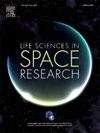Impact of weightlessness on dynamic deformation and haemodynamic parameters of the heart
IF 2.8
3区 生物学
Q2 ASTRONOMY & ASTROPHYSICS
引用次数: 0
Abstract
Cardiovascular disease remains an important challenge for human space travel, it is particularly important for astronaut health to accurately simulate cardiac conditions in weightless environments. In this study, a coupled flow-solid model of the left ventricular (LV) and mitral valve (MV) is developed by the immersed boundary/finite element (IB/FE) method, and the boundary conditions of the model were determined from the relationship between gravitational level, LV sphericity and LV end-diastolic pressure. Based on this model, the dynamic deformation and haemodynamic parameters of the LV and the MV are investigated in different gravitational environments, such as Zero Gravity, the Moon (0.167 g), the Mars (0.38 g) and the Earth. The validity and accuracy of the model is verified by comparing the Zero Gravity simulation results with the real data obtained from the space flight experiment. The prediction results of the model can provide some references on how to combat the adverse effects of weightlessness during spaceflight.
失重对心脏动态变形和血流动力学参数的影响
心血管疾病仍然是人类太空旅行面临的重要挑战,准确模拟失重环境下的心脏状况对宇航员的健康尤为重要。本文采用浸没边界/有限元(IB/FE)方法建立了左心室和二尖瓣的流固耦合模型,并根据重力水平、左室球形度和左室舒张末压之间的关系确定了模型的边界条件。在此基础上,研究了在零重力、月球(0.167 g)、火星(0.38 g)和地球等不同重力环境下,LV和MV的动态变形和血流动力学参数。通过将零重力仿真结果与实际航天飞行实验数据进行对比,验证了该模型的有效性和准确性。该模型的预测结果可为如何应对航天飞行中的失重不利影响提供一定的参考。
本文章由计算机程序翻译,如有差异,请以英文原文为准。
求助全文
约1分钟内获得全文
求助全文
来源期刊

Life Sciences in Space Research
Agricultural and Biological Sciences-Agricultural and Biological Sciences (miscellaneous)
CiteScore
5.30
自引率
8.00%
发文量
69
期刊介绍:
Life Sciences in Space Research publishes high quality original research and review articles in areas previously covered by the Life Sciences section of COSPAR''s other society journal Advances in Space Research.
Life Sciences in Space Research features an editorial team of top scientists in the space radiation field and guarantees a fast turnaround time from submission to editorial decision.
 求助内容:
求助内容: 应助结果提醒方式:
应助结果提醒方式:


